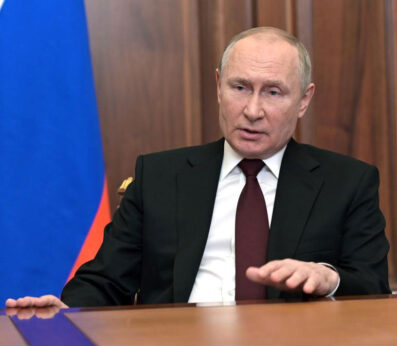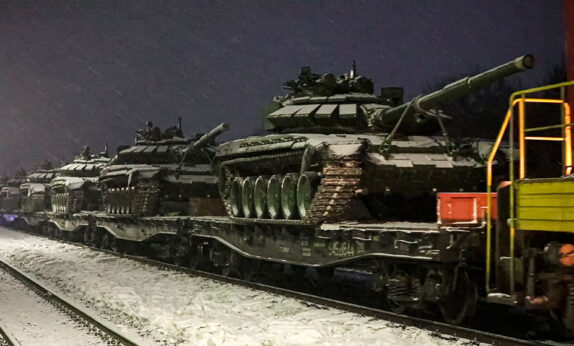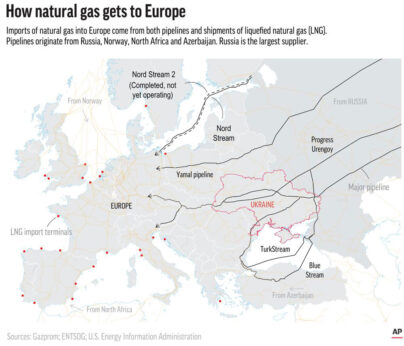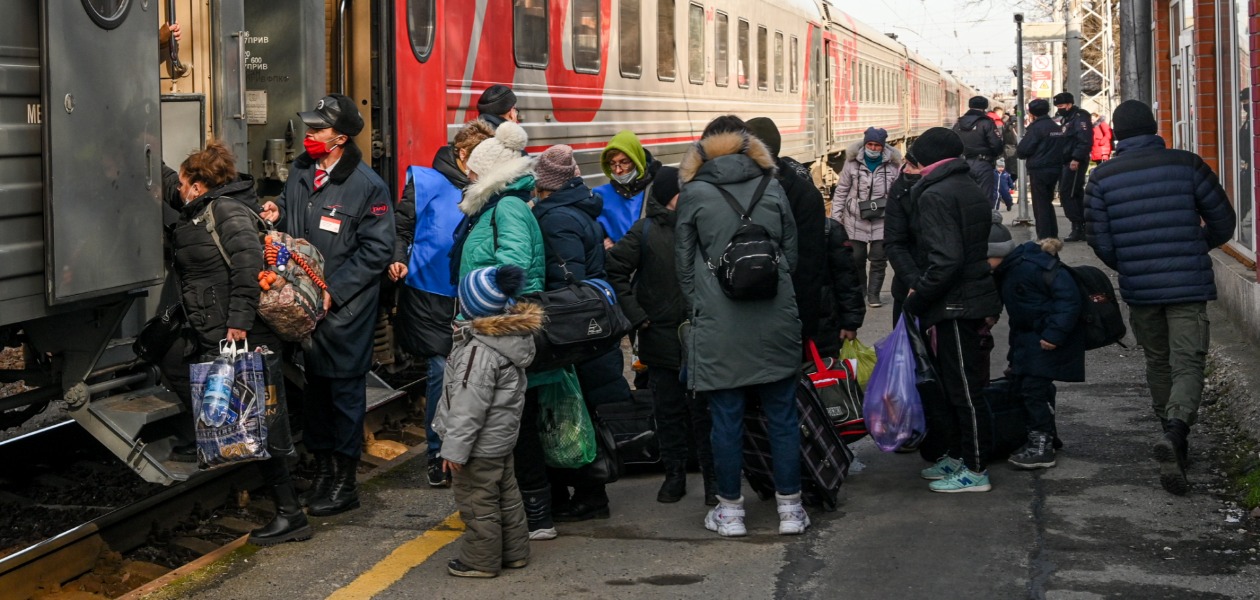NATO may get the war it wanted
February 22, 2022


The tension-raising announcement by Russia Monday did not, of course, come out of the blue. It followed months of bad faith negotiations by the West. Rather than implementing the 2014 Minsk Protocols under which the parties agreed to autonomy for Lugansk and Donetsk, for example, the West only offered Russia the right to inspect offensive missiles placed on its borders. To add insult to injury, while they were offering that, they established three additional bases with such missiles, two in Slovakia and one in Poland.
They also ignored French President Emmanuel Macron’s suggestion of a “Finlandization” solution for Ukraine whereby Ukraine, like Finland during the Cold War, selects its own form of government and remains independent while it pursues a nonaligned neutral foreign policy with no offensive weapons stationed on its soil and aimed at Russia.
Another unfortunate result of where all of this leaves us is that, unless all sides pull back from the brink and negotiate seriously, we already have an unwanted winner in this war.
The winner is the multi-national fossil fuel industries based in the U.S. The CEOs must have been rubbing their palms together with glee when they heard Biden warn Americans they will have to pay higher prices for energy as the U.S. imposes sanctions on Russia. Futures for gasoline and home heating oil were already up on Monday and Tuesday. Those companies hate the fact that Russia has been supplying Europe’s energy needs. They want to sell Europe their gas, fracked in the U.S., even though that gas will be far more expensive for Europe than the Russian gas.

BY JOHN WOJCIK AND C.J. ATKINS
PEOPLE'S WORLD

People from the Donetsk People's Republic, the territory controlled by a pro-Russia separatist government in eastern Ukraine, board a train to Russia after evacuating in the Rostov-on-Don region, near the border with Ukraine, Russia, on Sunday, Feb. 20, 2022. They were fleeing shelling by the Ukrainian Army. | AP
The big news regarding the Russia-Ukraine conflict over the President’s Day holiday was that Russia’s President Vladimir Putin ordered troops to enter two separatist regions of Ukraine for “peacekeeping” purposes. There has been no confirmation yet that Russian troops, in addition to those that may or may not have already been in those regions, have actually moved into the areas yet.

People from the Donetsk People's Republic, the territory controlled by a pro-Russia separatist government in eastern Ukraine, board a train to Russia after evacuating in the Rostov-on-Don region, near the border with Ukraine, Russia, on Sunday, Feb. 20, 2022. They were fleeing shelling by the Ukrainian Army. | AP
The big news regarding the Russia-Ukraine conflict over the President’s Day holiday was that Russia’s President Vladimir Putin ordered troops to enter two separatist regions of Ukraine for “peacekeeping” purposes. There has been no confirmation yet that Russian troops, in addition to those that may or may not have already been in those regions, have actually moved into the areas yet.

Russian President Vladimir Putin recognized the independence of the Donetsk and Lugansk People’s Republics in eastern Ukraine on Monday and signed friendship treaties with them, opening the way for Russian troops to come to their aid against Ukrainian forces. Western governments say it paves the way for a full-scale invasion of Ukraine and represents a major escalation by Russia.
| Alexei Nikolsky / Sputnik / Kremlin Pool Photo via AP
Russia’s order has been almost universally described by Western media as ratcheting up tensions and bringing the Ukraine crisis closer than ever to actual war. Putin ordered the troops to move in just hours after he recognized the independence of the Donetsk and Lugansk People’s Republics in the Donbass region of eastern Ukraine.
In the last two days, there has been extensive shelling of the areas by the Ukrainian Army, and at least 60,000 civilians have thus far evacuated across the border into Russia. Since 2014, Ukrainian troops are estimated to have killed 15,000 or more Russian-speaking civilians in the two breakaway republics.
Although cable networks carried parts of Putin’s speech on Monday, none carried the entirety of his remarks, which were a mix of nationalist territorial claims, revisionist history, and legitimate charges of Ukrainian hostility in the Donbass.
The press gave heavy attention to his provocative claim that Ukraine lacked “real statehood,” a position seen as justification for a potential Russian absorption of the country. The media provided little to no analysis of the details of Putin’s assertion, however.
In his speech, Putin laid out his own version of the history of Russian-Ukrainian relations, putting blame on Communist leaders of the Soviet era for upsetting “the historical destiny of Russia and its peoples” by focusing on the “right of nations to self-determination” in the years after the Bolshevik Revolution of 1917.
“Lenin’s principles of state development were not just a mistake,” Putin said, “they were worse than a mistake.” He said these principles, along with subsequent shifting of the internal territorial boundaries of the USSR by other leaders, led to what he implied were artificial divisions between Russians and Ukrainians. Putin said that governing such a vast territory as a “confederation,” as was the case in the Soviet period, was “far removed from reality” and the “tradition…of the Russian Empire.”
With the spotlight on Putin’s comments concerning territory and statehood issues, few U.S. media outlets provided much attention to his charge that the government in Kiev had organized “a terrorist underground movement” in the Donbass region and Crimea. Nor was note taken of the plans of Ukraine’s government, according to its own strategists, to execute a war “with foreign military support” against Russia and the breakaway regions in eastern Ukraine.
President Joe Biden, waiting barely a minute after Putin finished speaking, announced sanctions against the two republics of Lugansk and Donetsk. He is expected to announce new severe sanctions against Russia shortly.
It should be clear that even though they don’t involve “troops on the ground,” sanctions are, themselves, also an act of war. Russia has been living with a variety of painful sanctions imposed by the U.S. for eight years now already.
The raising of the stakes and the raising of tensions resulting from Putin’s announcement ordering in “peacekeepers” Monday are, at least in part, a predictable result of NATO, the U.S., and Ukraine ignoring a number of legitimate security issues repeatedly mentioned by Russia for the last 30 years, including and especially Russia’s objection to the eastward expansion of NATO and the placement of offensive weapons on Russia’s borders.
Russia’s order has been almost universally described by Western media as ratcheting up tensions and bringing the Ukraine crisis closer than ever to actual war. Putin ordered the troops to move in just hours after he recognized the independence of the Donetsk and Lugansk People’s Republics in the Donbass region of eastern Ukraine.
In the last two days, there has been extensive shelling of the areas by the Ukrainian Army, and at least 60,000 civilians have thus far evacuated across the border into Russia. Since 2014, Ukrainian troops are estimated to have killed 15,000 or more Russian-speaking civilians in the two breakaway republics.
Although cable networks carried parts of Putin’s speech on Monday, none carried the entirety of his remarks, which were a mix of nationalist territorial claims, revisionist history, and legitimate charges of Ukrainian hostility in the Donbass.
The press gave heavy attention to his provocative claim that Ukraine lacked “real statehood,” a position seen as justification for a potential Russian absorption of the country. The media provided little to no analysis of the details of Putin’s assertion, however.
In his speech, Putin laid out his own version of the history of Russian-Ukrainian relations, putting blame on Communist leaders of the Soviet era for upsetting “the historical destiny of Russia and its peoples” by focusing on the “right of nations to self-determination” in the years after the Bolshevik Revolution of 1917.
“Lenin’s principles of state development were not just a mistake,” Putin said, “they were worse than a mistake.” He said these principles, along with subsequent shifting of the internal territorial boundaries of the USSR by other leaders, led to what he implied were artificial divisions between Russians and Ukrainians. Putin said that governing such a vast territory as a “confederation,” as was the case in the Soviet period, was “far removed from reality” and the “tradition…of the Russian Empire.”
With the spotlight on Putin’s comments concerning territory and statehood issues, few U.S. media outlets provided much attention to his charge that the government in Kiev had organized “a terrorist underground movement” in the Donbass region and Crimea. Nor was note taken of the plans of Ukraine’s government, according to its own strategists, to execute a war “with foreign military support” against Russia and the breakaway regions in eastern Ukraine.
President Joe Biden, waiting barely a minute after Putin finished speaking, announced sanctions against the two republics of Lugansk and Donetsk. He is expected to announce new severe sanctions against Russia shortly.
It should be clear that even though they don’t involve “troops on the ground,” sanctions are, themselves, also an act of war. Russia has been living with a variety of painful sanctions imposed by the U.S. for eight years now already.
The raising of the stakes and the raising of tensions resulting from Putin’s announcement ordering in “peacekeepers” Monday are, at least in part, a predictable result of NATO, the U.S., and Ukraine ignoring a number of legitimate security issues repeatedly mentioned by Russia for the last 30 years, including and especially Russia’s objection to the eastward expansion of NATO and the placement of offensive weapons on Russia’s borders.

Russian army tanks are loaded onto railway cars to move back to their permanent base after drills in Russia on Friday, Feb. 18, 2022. The Russian military said it was pulling some troops back to their permanent bases after drills in regions near Ukraine, but the U.S. and its allies charged that Moscow was actually beefing up troops near Ukraine. Putin’s recognition of the breakaway regions of Donetsk and Lugansk in eastern Ukraine could bring about fresh Russian troop deployments.
| Russian Defense Ministry Press Service via AP
The tension-raising announcement by Russia Monday did not, of course, come out of the blue. It followed months of bad faith negotiations by the West. Rather than implementing the 2014 Minsk Protocols under which the parties agreed to autonomy for Lugansk and Donetsk, for example, the West only offered Russia the right to inspect offensive missiles placed on its borders. To add insult to injury, while they were offering that, they established three additional bases with such missiles, two in Slovakia and one in Poland.
They also ignored French President Emmanuel Macron’s suggestion of a “Finlandization” solution for Ukraine whereby Ukraine, like Finland during the Cold War, selects its own form of government and remains independent while it pursues a nonaligned neutral foreign policy with no offensive weapons stationed on its soil and aimed at Russia.
Another unfortunate result of where all of this leaves us is that, unless all sides pull back from the brink and negotiate seriously, we already have an unwanted winner in this war.
The winner is the multi-national fossil fuel industries based in the U.S. The CEOs must have been rubbing their palms together with glee when they heard Biden warn Americans they will have to pay higher prices for energy as the U.S. imposes sanctions on Russia. Futures for gasoline and home heating oil were already up on Monday and Tuesday. Those companies hate the fact that Russia has been supplying Europe’s energy needs. They want to sell Europe their gas, fracked in the U.S., even though that gas will be far more expensive for Europe than the Russian gas.

Imports of natural gas into Europe come from both pipelines and via ship terminals for liquefied natural gas (LNG). The Ukrainian government worries it could lose massive amounts of revenue if the joint German-Russian Nord Stream 2 pipeline becomes operational, as Kiev currently collects hefty transit payments for Russian gas that crosses its territory. Western-based oil and gas companies, which rely on the LNG terminals to import their products, stand to see handsome profits from possible disruptions to Russian gas sales. | via AP
Western gas and oil companies got part of what they wanted Tuesday morning when German Chancellor Olaf Scholz announced that the Nord Stream 2 pipeline, a joint Russian-German project completed last year and due to become operational by mid-2022. Scholz’s decision will directly benefit the gas giants by keeping Europe’s consumption of cheap Russian gas capped at current levels, or even less. That means more profits from European purchases of fracked U.S. gas.
The Ukrainian government was also excited by the pipeline blockade, as a major part of its annual revenues come from acting as middleman fees for current overland pipelines between Russia and Europe. Foreign Minister Dmytro Kuleba praised Germany’s move as “a morally, politically, and practically correct step in the current circumstances.”
Americans, meanwhile, will be expected to pay more to help offset the costs to Europeans of an obscene profit-making machine operated by the fuel monopolies—a machine that has no concern whatsoever for Ukrainians, Russians, or Americans. The other winners of this war, of course, are the arms and munitions companies who drive up the U.S. military budget and take money from the social programs urgently needed at home.
In the most serious crisis to envelop Europe since the Cold War, NATO has proven, once again, that it cannot meet the security needs of Europe and that a new security framework for the continent is sorely needed. An organization that takes in all of Europe, including Russia, on an equal basis, would be a sane and sensible way to go.
FURTHER COVERAGE:
> Pipeline ploy: How U.S. natural gas interests are fueling the Ukraine crisis
> Ukrainian fascists say they will sabotage any peace deal with Russia
> U.S. ramps up war talk as it points more missiles at Russia
CONTRIBUTOR

John Wojcik is Editor-in-Chief of People's World. John Wojcik es editor en jefe de People's World. He joined the staff as Labor Editor in May 2007 after working as a union meat cutter in northern New Jersey. There, he served as a shop steward and a member of a UFCW contract negotiating committee. In the 1970s and '80s, he was a political action reporter for the Daily World, this newspaper's predecessor, and was active in electoral politics in Brooklyn, New York.

C.J. Atkins is the managing editor at People's World. He holds a Ph.D. in political science from York University in Toronto and has a research and teaching background in political economy and the politics and ideas of the American left. In addition to his work at People's World, C.J. currently serves as the Deputy Executive Director of ProudPolitics.
Western gas and oil companies got part of what they wanted Tuesday morning when German Chancellor Olaf Scholz announced that the Nord Stream 2 pipeline, a joint Russian-German project completed last year and due to become operational by mid-2022. Scholz’s decision will directly benefit the gas giants by keeping Europe’s consumption of cheap Russian gas capped at current levels, or even less. That means more profits from European purchases of fracked U.S. gas.
The Ukrainian government was also excited by the pipeline blockade, as a major part of its annual revenues come from acting as middleman fees for current overland pipelines between Russia and Europe. Foreign Minister Dmytro Kuleba praised Germany’s move as “a morally, politically, and practically correct step in the current circumstances.”
Americans, meanwhile, will be expected to pay more to help offset the costs to Europeans of an obscene profit-making machine operated by the fuel monopolies—a machine that has no concern whatsoever for Ukrainians, Russians, or Americans. The other winners of this war, of course, are the arms and munitions companies who drive up the U.S. military budget and take money from the social programs urgently needed at home.
In the most serious crisis to envelop Europe since the Cold War, NATO has proven, once again, that it cannot meet the security needs of Europe and that a new security framework for the continent is sorely needed. An organization that takes in all of Europe, including Russia, on an equal basis, would be a sane and sensible way to go.
FURTHER COVERAGE:
> Pipeline ploy: How U.S. natural gas interests are fueling the Ukraine crisis
> Ukrainian fascists say they will sabotage any peace deal with Russia
> U.S. ramps up war talk as it points more missiles at Russia
CONTRIBUTOR

John Wojcik is Editor-in-Chief of People's World. John Wojcik es editor en jefe de People's World. He joined the staff as Labor Editor in May 2007 after working as a union meat cutter in northern New Jersey. There, he served as a shop steward and a member of a UFCW contract negotiating committee. In the 1970s and '80s, he was a political action reporter for the Daily World, this newspaper's predecessor, and was active in electoral politics in Brooklyn, New York.

C.J. Atkins is the managing editor at People's World. He holds a Ph.D. in political science from York University in Toronto and has a research and teaching background in political economy and the politics and ideas of the American left. In addition to his work at People's World, C.J. currently serves as the Deputy Executive Director of ProudPolitics.
By Meghann Myers
Feb 22,
:quality(70)/cloudfront-us-east-1.images.arcpublishing.com/mco/SZO3AHWJB5FIXLUEN4IHJPZASI.jpg)
Feb 22,
:quality(70)/cloudfront-us-east-1.images.arcpublishing.com/mco/SZO3AHWJB5FIXLUEN4IHJPZASI.jpg)
These are the first of 2,000 Soldiers to arrive in Europe following the Pentagon’s announcement of additional forces moving from the United States to Europe in support of our NATO allies. The XVIII Airborne Corps, will provide a Joint Task Force-capable headquarters in Germany, as 1,700 Paratroopers from the 82nd Airborne Division deploy to Poland.
(U.S. Army photo by Sgt. Stephen P. Perez)
Another round of U.S. troops has been mobilized in support of Eastern European countries as Russia further invades Ukraine.
Joining 6,000 troops already activated in Germany, Poland and Hungary, the Defense Department announced Tuesday that a spate of combat aircraft and infantry troops will head to the Baltics and Poland.
They include:
800 soldiers from an Italy-based infantry battalion task force to the Baltic states
Up to eight Air Force F-35 strike fighters from Germany to the Baltics, as well as an unspecified location on NATO’s southeastern flank
An attack aviation battalion with 20 AH-64 Apache helicopters, from Germany to the Baltics
An attack aviation task force with 12 Apaches from Greece to Poland
“These additional personnel are being repositioned to reassure our NATO allies, deter any potential aggression against NATO member states, and train with host-nation forces,” according to a senior defense official.
The announcement came after President Joe Biden detailed new economic sanctions on Russia in reaction to Russian Vladimir Putin’s decision to move new military forces into separatist-held parts of Ukraine.
“Who in the Lord’s name is Putin to think it gives him the right to declare new so-called borders on territory that belong to his neighbors?” Biden said. “This a flagrant violation of international law and demands a firm response from the international community.”
Biden said the United States “will continue to provide defensive assistance to Ukraine” as Russian forces advance, but reiterated that “we have no intention of fighting Russia.”
However, he said that American military forces will continue to work with NATO allies on how to diffuse the situation and defend their borders.
“We want to send an unmistakable message that the United States together with our allies will defend every inch of NATO territory and abide by the commitments we made into NATO,” he said. “We still believe that Russia is poised to go much further in launching a massive military attack against Ukraine. I hope we’re wrong about that.”
NATO forces are on heightened alert as Russia sends troops into parts of eastern Ukraine, but the response force hasn’t been activated, NATO Secretary General Jens Stoltenberg told reporters on Tuesday.
The multinational, 40,000-troop force is ready to respond to aggressive actions on Russia’s part, along with thousands of U.S. troops who have been put on shortened prepare-to-deploy orders.
“So far we have increased the readiness of the NATO Response Force, but we’re not deployed,” Stoltenberg said during a press conference.
Instead, individual countries have activated their own troops on an ad-hoc basis. That includes 5,000 troops from Fort Bragg, North Carolina, who headed to Germany and Poland earlier this month, and another 1,000 mobilized from Germany to Romania.
At the same time, Stoltenberg said, Germany has sent troops to Lithuania, the United Kingdom has doubled its troops in Estonia.
“And other allies ― including Spain, the Netherlands, Denmark, and many others ― have decided to send in troops ships and planes to reinforce our presence,” he added.
RELATED
:quality(70)/cloudfront-us-east-1.images.arcpublishing.com/mco/4SF3NDM56NBZRFUKBKEJXCRIHU.jpg)
Ukraine
‘Our troops will be fine,’ Austin says of US forces in Europe amid Ukraine threat
Another round of U.S. troops has been mobilized in support of Eastern European countries as Russia further invades Ukraine.
Joining 6,000 troops already activated in Germany, Poland and Hungary, the Defense Department announced Tuesday that a spate of combat aircraft and infantry troops will head to the Baltics and Poland.
They include:
800 soldiers from an Italy-based infantry battalion task force to the Baltic states
Up to eight Air Force F-35 strike fighters from Germany to the Baltics, as well as an unspecified location on NATO’s southeastern flank
An attack aviation battalion with 20 AH-64 Apache helicopters, from Germany to the Baltics
An attack aviation task force with 12 Apaches from Greece to Poland
“These additional personnel are being repositioned to reassure our NATO allies, deter any potential aggression against NATO member states, and train with host-nation forces,” according to a senior defense official.
The announcement came after President Joe Biden detailed new economic sanctions on Russia in reaction to Russian Vladimir Putin’s decision to move new military forces into separatist-held parts of Ukraine.
“Who in the Lord’s name is Putin to think it gives him the right to declare new so-called borders on territory that belong to his neighbors?” Biden said. “This a flagrant violation of international law and demands a firm response from the international community.”
Biden said the United States “will continue to provide defensive assistance to Ukraine” as Russian forces advance, but reiterated that “we have no intention of fighting Russia.”
However, he said that American military forces will continue to work with NATO allies on how to diffuse the situation and defend their borders.
“We want to send an unmistakable message that the United States together with our allies will defend every inch of NATO territory and abide by the commitments we made into NATO,” he said. “We still believe that Russia is poised to go much further in launching a massive military attack against Ukraine. I hope we’re wrong about that.”
NATO forces are on heightened alert as Russia sends troops into parts of eastern Ukraine, but the response force hasn’t been activated, NATO Secretary General Jens Stoltenberg told reporters on Tuesday.
The multinational, 40,000-troop force is ready to respond to aggressive actions on Russia’s part, along with thousands of U.S. troops who have been put on shortened prepare-to-deploy orders.
“So far we have increased the readiness of the NATO Response Force, but we’re not deployed,” Stoltenberg said during a press conference.
Instead, individual countries have activated their own troops on an ad-hoc basis. That includes 5,000 troops from Fort Bragg, North Carolina, who headed to Germany and Poland earlier this month, and another 1,000 mobilized from Germany to Romania.
At the same time, Stoltenberg said, Germany has sent troops to Lithuania, the United Kingdom has doubled its troops in Estonia.
“And other allies ― including Spain, the Netherlands, Denmark, and many others ― have decided to send in troops ships and planes to reinforce our presence,” he added.
RELATED
:quality(70)/cloudfront-us-east-1.images.arcpublishing.com/mco/4SF3NDM56NBZRFUKBKEJXCRIHU.jpg)
Ukraine
‘Our troops will be fine,’ Austin says of US forces in Europe amid Ukraine threat
Defense Secretary Lloyd Austin says the United States will do its due diligence to protect American troops should Russia invade Ukraine.
By Jessica Edwards
Leaders from Lithuania, Latvia and Estonia met with Vice President Kamala Harris in Munich on Friday, calling for more support to the Baltic countries.
“We welcome the decisions already made by the U.S. administration to deploy additional forces in Europe. And we also hope that you increase the presence in the Baltic countries,” Estonian Prime Minister Kaja Kallas said Friday.
And while visiting a small number of U.S. troops deployed to Lithuania on Saturday, Defense Secretary Lloyd Austin declined to say whether he was considering sending more troops to the Baltic state.
“I don’t have any ... announcements to make today in terms of troop presence,” Austin told reporters during a press conference in Vilnius. “But as I said, I’ve been saying all long, we will continue to assess situations and consult with our allies.”
Stoltenberg said the risk of a “full-scale” assault on Ukraine remained high as Russian troops surrounding the country appeared “out of the camps and in attack positions.” That assessment expands the scope of a potential conflict beyond the Russia-supported breakaway provinces of Luhansk and Donetsk in the eastern Ukraine.
Russian President Vladimir Putin’s government recognized the regions’ affiliation with Moscow on Monday, drawing the ire of the international community.
Shortly after Stoltenberg’s press conference on Tuesday, Russian news reports began trickling in that Putin’s independence proclamation would cover the entirety of the respective provinces, parts of which are still under Ukrainian control, setting up the prospect of intensified combat along the contact line splitting the region.
About Meghann Myers
Meghann Myers is the Pentagon bureau chief at Military Times. She covers operations, policy, personnel, leadership and other issues affecting service members. Follow on Twitter @Meghann_MT
No comments:
Post a Comment